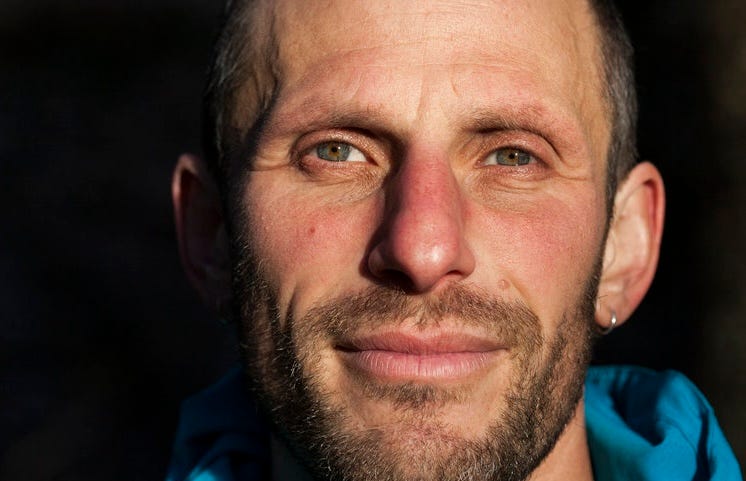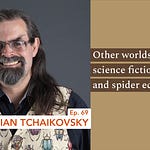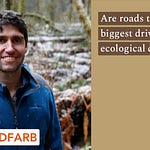My guest today is David Moskowitz. He is an award-winning photographer and wildlife biologist whose new book is Big River: Resilience and Renewal in the Columbia Basin.1 It is a colorful collection of hard-won landscape shots, charismatic wildlife, and indigenous perspectives on an iconic western watershed.
We discussed documentarian ethics, wildlife photography with drones and camera traps, his conservation work with wolverines, salmon hatcheries, and the elusive kangaroo rat.
We spoke in July 2024.
This edition of Ryan’s Corner is sponsored by Mile High Life, the maker of my favorite dog leash.
Use promo code “RyansCorner” to get 15% off your order at milehighlife.us
Ryan: As a photographer, what is it that you like about still photos compared to capturing video?
David: I’m definitely a photographer by choice and do videography work by necessity in the modern world.
In a photo, you’re trying to tell an entire story in one frame. It’s very challenging in that way, but it’s also very rewarding to figure out the components of the story and how to blend those together. What is the image that’s going to tell this story? I enjoy that challenge and the aesthetics.
Ryan: The photographs in your book Big River are beautiful. I love the wildlife shots, but also the geology and places that look like they’d be hard to get to. Which photo in the book was the most physically demanding to capture?
David: That would be the photos of the Columbia ice field, in the opening of the “headwaters” section of the book.
Me and my buddy Jeff Rose2 went up there to make these images. He was helping me carry camera equipment, and we were going to go on skis or on foot. But when we got to the base of where we were going to hike in, all we could see was miles of dirt and dry glacier where we couldn’t use our skis.
So we went on foot. But as soon as we got to the ice field proper, we were post-holing through knee deep, horrible snow, wishing we had our skis. I was carrying a drone up there and camera equipment and overnight stuff, glacier travel stuff. That was was a really fun trip, but arduous. And it really paid off, because those images are such a unique part of the watershed. It’s such an archetypal image of what headwaters look like. I was glad I did that.
The second option I would choose, but no photos made it into the book, I did a 63 mile round-trip trail run to the headwaters of the Snake River, and we got stuck in a massive lightning and rainstorm right when we got there to the headwaters. We went into survival mode to avoid getting hypothermia, and I wasn’t able to set up and take the photos I wanted, but it was a great adventure.
Ryan: That’s the largest roadless area in the lower 48, right?
David: Yeah, we were out there in the southeastern corner of Yellowstone National Park. Most people don’t think about Yellowstone being in the Columbia River watershed, but parts of it are.
Ryan: How long do you reckon humans have been in North America?
David: I am not an expert on that, but what I will say is that you’ll get, depending on who you ask and what frame of reference you choose, you’ll get different answers.
If you talk to archaeologists and anthropologists, they’ll give you a numbers like 20,000 years, based on scientific evidence.3
If you talk to indigenous peoples, they’ll say we’ve been here forever.
But if you talk to indigenous peoples, they’ll say we’ve been here forever. One of my jobs as a documentarian is to tell stories from the frame of reference of the people that I’m telling stories about. So for them, the answer is “since the beginning of time”.
Ryan: What sort of challenges did you face getting indigenous people to share with your project?
David: I would take a step back from that and say everybody that I photographed for this project, whether indigenous or members of the settler colonial culture, can start off wary when you approach them with a camera saying, “I want to take pictures of you for a project”.
They’re like, “why do you want to do that? What are you going to use it for and what’s your reference?”. Indigenous peoples have a long history of having their culture misappropriated. So there’s sensitivity. But it was delicate even when I was photographing commercial fishermen.
Commercial fisherman are sometimes looked down upon by other segments of society. They were a bit wary, “are you going to make us out to be bad guys?”. Block operators that work at the dams had the same kind of issues.
As a photographer and documentarian working to tell the stories of people, I always approach that trying to just understand. I try to communicate that my goal is to understand their perspective and create images that present their perspective in a way that feels genuine and authentic.
We always go back to people to check quotes. I’m not interested in catching weird soundbites to fit my narrative, that don’t reflect the actual ideas of the people I’m covering in stories. If what you said in the moment doesn’t line up with what you actually mean, then edit it. Give me what you actually mean. What do you actually think about the Columbia River? That’s what I want. I’m trying to provide a window into your frame of reference.
That seems to help when people realize that I’m genuinely curious about their perspective. That opens doors to being willing to share. For things that are important to them, having the opportunity to share their perspective in a way that might affect other people is valuable.
I saw that in Indigenous and non-indigenous communities, that when they felt safe, like they had a non-biased platform, they were willing to open up and share.
Ryan: If you could change something about the management of the Columbia River Basin, what would you do?
David: I would have the value of ecosystem services taken into account consistently and clearly. A lot of times management decisions on this river, and resource management decisions in our society in general, do a lot of externalizing.
Costs get externalized and don’t show up in the accounting. Projects go forward because they’re able to get taxpayers to pay for a road to be built, and the resource extraction activity becomes profitable.
A lot of resource use on the Columbia River right now only makes sense economically because we are externalizing the costs of those activities. How we manage water, the impacts on our ecosystems, the impacts on salmon, we’re not taking into account the cost. We destroy a watershed and floodplain and then have to go back and provide flood control at the taxpayer’s expense.
We also aren’t taking into account the ecosystem benefits, how this watershed naturally sequesters carbon or stores water in forests and snow pack.
We don’t do a good job of accounting for the way ecosystem services are of economic value, and I think if we did that, we would have very different management decisions.
Ryan: Are beaver dams an obstacle to migrating salmon similar to human built dams?
David: Haha, absolutely not! I believe the longest beaver dam in the world was found up in Canada and was two and a half miles long, which is huge, but it’s only a few feet tall. In one particular instance a beaver dam might provide a small obstacle to fish at certain water levels. But in general, the presence of beavers in the watershed makes a better landscape for fish by creating downed trees, cover structure, and sloughs. It creates diverse features in a river system, and different salmon need different features.
Beavers retain water in the ecosystem so it can flow out slowly. It’s another way to store water, and not just in a pond, but by raising the whole water table in an area. The more water in an area, the better it is for fish in general.
Ryan: Should every hydroelectric dam have a salmon ladder?
David: I think any hydro dam on a fish bearing stream should include passage for those fish in some capacity, whether that’s a fish ladder or another new technology.
It comes back to the point of understanding that rivers do more than provide hydropower or irrigation. They provide ecological function. The freedom of fish, whether they’re anadromous or non-anadromous, to travel the river corridor is a sign that we’ve preserved the ecological function of that river. If we have fish, we’re going to have other benefits.
Ryan: You mentioned in your book that relying on hatcheries may have been be a bit of a strategic trap. Would you prefer to see more or fewer hatcheries relied on as a conservation strategy?
David: Hatcheries in the past have been used to try to replace wild salmon stocks, or make up for the destruction of their habitat, and that has, by and large, not worked.
We’ve had decades of trying to use hatcheries to replace wild fish, and we have less fish than ever. Clearly something’s wrong with that model. That being said, the way we are using hatcheries today is different than how we used them 80 years ago.
There is a role today in hatcheries continuing to help provide subsistence fishing opportunities for Indigenous people, which is their right to have. Without some of the hatcheries we have, their opportunities to feed themselves their traditional food would be lost.
Getting rid of hatcheries today would not fix our problems.
Ryan: There might be issues around how they impact genetic diversity?
David: They can be real problems for genetic diversity, or they can help with that. If you take salmon genetics from the place you’re trying to recover fish, make more of them in a hatchery and release them, and get them back flowing to the ocean habitat, that could be a net win. But if you’re totally swamping a very small wild stock of salmon with thousands of genetically dissimilar salmon that are then competing with the wild fish for food and such, then you’re creating a big problem.
Ryan: You had a great photo of a lamprey eel and mentioned it is an indigenous food source. Did you get a chance to taste one?
David: I didn’t, but I definitely would if I had the opportunity in an ethical way. I’d be delighted to taste a lamprey. From what I heard talking to Lou George and a couple other folks, it’s quite tasty. It’s an oily fish but people like it.
Ryan: What advances in technology or equipment have changed the way you do your work? When you think about lightweight versus performance capabilities and batteries and thermal sensors, are you a guy who likes to try out new stuff?
David: I shoot all mirrorless now for wildlife photography, having a camera that’s totally silent when it takes pictures allows for more intimate wildlife encounters.
Ryan: A silent shutter makes a big difference?
David: Absolutely. Not for some animals and not in all conditions, but in many cases it’s a really big difference.
The mountain lion in the book was lit with three strobes, and the animal took its own photograph by the motion sensor. That relied on radio triggers for the flashes and a lot of technology to produce an image that I had in my mind. It’s a window into that animal’s world that I’d like to say takes a little bit of skill and a lot of imagination, and then the right equipment.
Ryan: So anybody who’s trying to step up their camera trap game could look into coordinated lighting setups.
David: You can’t do that for every species. Canines are wary of anything human. If you flash them, they’re gone. But cats are super chill. You can flash them day and night and create some interesting images.
In the same way I don’t want my images to hurt people by misrepresenting them, I don’t want my images to hurt wildlife, and that could be by displacing them or scaring them off.
I try to fit the style of photography to what the animal will tolerate.
Ryan: The wolf photo was probably the funniest photo in the book. His expression made me laugh.
David: That camera was set for a lynx. I got a wolf instead. There were three photos, and in the first one the flash goes off, then the next one it’s looking startled, and the third one it’s gone. Whereas with cats they’ll get flashed again and again. They don’t flinch at all.
Ryan: Would you call that confidence? Are mountain lions more confident than wolves?
David: No, I think they just approach the world in a different way.
Wolves and people have a long, antagonistic history and they’re quite smart. A wolf’s concern about weird human objects in the wilderness probably represents a level of learning and intelligence that is quite exceptional.
Ryan: What was the most mysterious animal you photographed?
David: The two that come to mind are the wolverine and kangaroo rat. I love wolverines. I’ve been studying them for six years here in the North Cascades, and I’ve never seen one with my own eyes. That qualifies as mysterious.
They never have to drink water their whole lives.
The other one was the kangaroo rats. There’s a photo in the book of one that lives out in the desert along the Columbia and these guys come out only at night. They are super adapted to the desert. They never have to drink water their whole lives.4 They metabolize all their water out of the food they eat. It’s like a critter that Dr. Seuss would imagine.
Ryan: What is the Cascade Wolverine Project?
David: I’m one of the co-founders of Cascades Wolverine Project5 with Steph Williams, who’s a friend and colleague, a mountain guide and biologist.
We started that project to monitor and keep track of wolverines in our region. They’re a bit of a flagship species, and you can get people excited about wolverines, and that can engage them in broader conservation.
We wanted to engage the public who are recreating in wolverine habitat to be champions of wolverines rather than detractors who are worried that the presence of wolverines might impact their recreational options negatively.
Ryan: I love wolverines. Would you say pound-for-pound the bravest animal?
David: They’re pretty feisty, absolutely. Their willingness to fend fend off larger carnivores is a little bit overstated. They generally still follow the rule that the bigger predator turns out better in any altercation. But they do have tenacity and they’re not afraid if they’re backed into a corner. They’ll stand up to a person or a bear or wolves that are much bigger than them.
Ryan: Are they mostly solitary? Do they have social behaviors?
David: They are considered a solitary animal. They don’t live in extended family groups over many years or generations. They’re not colonial. It’s typically an individual animal with a home range and males exclude other males from that home range, and females do the same.
But we are learning that their social world is more complicated than that. Males will come and visit their kids every once in a while.
I believe there’s some evidence of resource sharing, not at the level of African lions or wolves. But it’s not purely every wolverine for themselves.
Ryan: When salmon are spawning, why is it that they start to look like goblins?
David: I’m not sure about the function of the visual changes, but when anadromous salmon enter freshwater on their way to spawn, most of them will die. They don’t return to the saltwater. It’s a one way trip, and they stop eating when they enter freshwater.
They’re living off the fat that they’ve stored in their bodies. And they actually start digesting some of their own internal organs to create energy to continue that journey. Their body becomes a reservoir of energy to complete their final task, which is to make it upstream to spawn and protect their eggs as long as they can. They they die and their body actually disintegrates into nutrients that feed the young.
That process of changing how they appear is probably a reflection of their systems shutting down.
Ryan: If you were submitting a question to a presidential debate, what’s a question you would ask the candidates?
David: It would be something going back to the start of our conversation about how would you propose that we better live within our finite resources and integrate ecological function and ecological services into our economic system.
Ryan: David, thank you so much for your time today. It’s been great talking to you.
David: Thanks a lot.
David Moskowitz’s latest book is Big River: Resilience and Renewal in the Columbia Basin. He previous books include Caribou Rainforest, Wildlife of the Pacific Northwest, and Wolves in the Land of Salmon, and Peterson’s Field Guide to North American Bird Nests.
His website is https://davidmoskowitz.net.
Fossilized human footprints in New Mexico dated to 23,000 years ago
Kangaroo rat never drinks water its whole life







